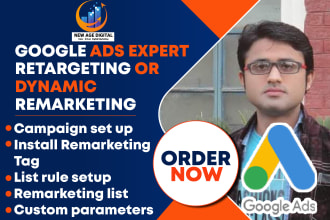Browse categories
Retargeting
Expand your reach by retargeting your ads to relevant customers
|126 Results
Sort by:

Fiverr’s
Choice
I will do google ads performance max campaigns across all channels
From $100
Offers video consultations
Level 2
I will design google display banner ads, web banner ads, adwords design
From $15
Offers video consultations
Retargeting FAQs
What is retargeting, and how does it work?
Retargeting is a type of digital advertising that targets individuals who have previously interacted with a website or are already present in a company's database. Its primary purpose is to follow potential customers who have left a website without making a purchase and create touchpoints to remind them of products and services they were interested in. Retargeting uses cookies to display relevant ads or send customized emails to remind visitors of items from the store they viewed but did not purchase. To drop cookies in a user’s browser, a piece of JavaScript code or pixel is added to a website’s pages. In the retargeting process, these cookies identify users and their behavior.
How can retargeting help my business?
Retargeting helps increase your chances of enticing customers back to your website and compelling them to purchase your products or services, ultimately leading to increased revenue for your business. To be more specific, here are some of the ways retargeting can help your business: - Generate more awareness for your brand, products and services. - Increase engagement with new visitors and customers, especially inactive ones. - Increase customer lifetime value by encouraging repeat purchases. - Recover abandoned carts and reduce cart abandonment rates. - Drive conversions and direct prospects to your site.
Can retargeting be used for both B2B and B2C companies?
Yes, retargeting can be used for both B2B and B2C companies. Retargeting is more commonly used for B2C marketing, but it is also an effective advertising method for the B2B sector. It can keep a brand top of mind for both B2B and B2C audiences. In B2C, retargeting can remind potential customers of products they showed interest in but didn't purchase. In B2B, it can remind potential customers of services or solutions they viewed but didn't inquire about. Since the goals and scope of services differ between the two, retargeting strategies must be tailored to the specific needs and interests of the target audience.
What are some common types of retargeting campaigns?
Retargeting can either be pixel-based or list-based. Pixel-based retargeting uses cookies to determine what specific ads to show users. In contrast, list-based retargeting uses a list of contact information uploaded to a platform that serves retargeting ads. These retargeting campaigns can be further classified according to the channels they run. Some of the most common types include: - Site retargeting - shows ads to people who have previously visited your website but did not convert. - Search retargeting – shows ads to people who have searched for specific keywords related to your business but did not visit your website. - Email retargeting (remarketing) - sends personalized emails to people who have interacted with your brand through email but did not take action. - Social media retargeting - displays ads to people who have engaged with your brand on social media but have not converted.
How does retargeting differ from traditional display advertising?
Traditional display advertising involves showing ads to a broad audience without specific targeting. These are attempts to start an engagement with new visitors or prospective customers. On the other hand, retargeting is focused on users who have already shown interest in a particular product or service. In traditional display advertising, ads may have a more generic message to reach a wider audience. Since retargeting ads are shown only to users who have visited a website or shown interest in a product or service, ads have more personalized messaging that speaks directly to the user’s interests and needs.
How does retargeting fit into my overall digital advertising strategy?
Retargeting can play a crucial role in your overall digital advertising strategy. It allows you to reach out to prospects who have already shown an interest in your brand or products – people who are already more likely to convert into paying customers. With your audience already highly engaged, retargeting can often be done at a much lower cost and faster ROI than traditional ad methods. Aside from being cost-effective, retargeting allows you to reach your prospects, whatever platform or channel they may be, and entice them to return to your website for conversions. By incorporating retargeting into your digital advertising strategy, you can increase your chances of driving conversions, generating awareness, and increasing customer lifetime value.















